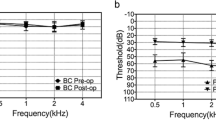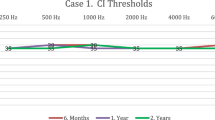Abstract
Objective
The aim of the study is to evaluate the importance of acoustic modifications generated by different commercially available ear-tips, focused on domes of receiver in the canal hearing aids using Real Ear Measurement (REM).
Methods
We enrolled 110 people selecting 200 ears bearers of hearing aids. In every patient, we performed REM and audiological tests with three different dome types: Open, Tulip and Double Closed (DC). Data about real-ear occluded gain (REOG), Pure Tone Average (PTA), Word Recognition Score (WRS) with aids switched on in Free Field, Ear and Auditory Comfort were collected and analyzed.
Results
REOG gain was statistically significant different between the three types of dome, with a DC that always closes the external auditory canal (EAC) (p < 0.001). There was no statistically significant difference between the PTA (p = 0.11). Regarding the WRS there were statistically significant differences between Open and DC dome (p < 0.001) and between Tulip and DC dome (p < 0.001), with worse discrimination when using DC. Both auditory and ear comfort are worse in the DC than in the other two domes (p < 0.001). From measured REOG gain values, in 135 cases Tulip dome does not occlude the EAC, with a statistically significant difference compared to DC (p < 0.001; Odd Ratio 0.0012; 95% CI 0.001–0.0196).
Conclusion
Our study confirms the necessity to perform REM to evaluate if the prescription target is achieved, especially when tulip domes are used, because they may not occlude the ear canal, causing in some cases the reduction of the vocal discrimination.


Similar content being viewed by others
References
Ciodaro F, Freni F, Mannella VK, Gazia F, Maceri A, Bruno R et al (2019) Use of 3D volume rendering based on high-resolution computed tomography temporal bone in patients with cochlear implants. Am J Case Rep 20:184–188
Galletti B, Gazia F, Freni F, Nicita RA, Bruno R, Galletti F (2019) chronic otitis media associated with cholesteatoma in a case of the Say-Barber-Biesecker-Young-Simpson Variant of Ohdo Syndrome. Am J Case Rep 20:175–178
Amorini M, Romeo P, Bruno R, Galletti F, Di Bella C, Longo P et al (2015) Prevalence of Deafness-Associated Connexin-26 (GJB2) and Connexin-30 (GJB6) Pathogenic Alleles in a Large Patient Cohort from Eastern Sicily. Ann Hum Genet 79(5):341–349
Kiessling J (2001) Hearing aid fitting procedures–state-of-the-art and current issues. Scand Audiol Suppl 52:57–59
Levitt H (1992) Adaptive procedures for hearing aid prescription and other audiologic applications. J Am Acad Audiol 3(2):119–131
Winkler A, Latzel M, Holube I (2016) Open versus closed hearing-aid fittings: a literature review of both fitting approaches. Trends Hear 15:20
Robinson SR, Nguyen CT, Allen JB (2013) Characterizing the ear canal acoustic impedance and reflectance by pole-zero fitting. Hear Res 301:168–182
Jespersen CT, Møller KN (2013) Reliability of real ear insertion gain in behind-the-ear hearing aids with different coupling systems to the ear canal. Int J Audiol 52(3):169–176
Denys S, Latzel M, Francart T, Wouters J (2019) A preliminary investigation into hearing aid fitting based on automated real-ear measurements integrated in the fitting software: test-retest reliability, matching accuracy and perceptual outcomes. Int J Audiol 58(3):132–140
Scollie S, Bagatto M, Moodie S, Crukley J (2011) Accuracy and reliability of a real-ear-to-coupler difference measurement procedure implemented within a behind-the-ear hearing aid. J Am Acad Audiol 22(9):612–622
Vaisberg JM, Folkeard P, Pumford J, Narten P, Scollie S (2018) Evaluation of the repeatability and accuracy of the wideband real-ear-to-coupler difference. J Am Acad Audiol 29(6):520–532
Munro KJ, Toal S (2005) Measuring the real-ear to coupler difference transfer function with an insert earphone and a hearing instrument: are they the same? Ear Hear 26(1):27–34
Moodie S, Pietrobon J, Rall E, Lindley G, Eiten L, Gordey D et al (2016) Using the real-ear-to-coupler difference within the American Academy of Audiology Pediatric Amplification Guideline: Protocols for Applying and Predicting Earmold RECDs. J Am Acad Audiol 27(3):264–275
Gustafson S, Pittman A, Fanning R (2013) Effects of tubing length and coupling method on hearing threshold and real-ear to coupler difference measures. Am J Audiol 22(1):190–199
Bagatto M, Moodie S, Scollie S, Seewald R, Moodie S, Pumford J et al (2005) Clinical protocols for hearing instrument fitting in the Desired Sensation Level method. Trends Amplif 9(4):199–226
Munro KJ, Millward KE (2006) The influence of RECD transducer when deriving real-ear sound pressure level. Ear Hear 27(4):409–423
Gazia F, Abita P, Alberti G, Loteta S, Longo P, Caminiti F et al (2019) NICU infants & SNHL: experience of a western Sicily tertiary care centre. Acta Medica Mediterranea 35(2):1001–1007
Munro KJ, Salisbury VA (2002) Is the real-ear to coupler difference independent of the measurement earphone? Int J Audiol 41(7):408–413
Galletti F, Freni F, Gazia F, Galletti B (2019) Endomeatal approach in cochlear implant surgery in a patient with small mastoid cavity and procident lateral sinus. BMJ Case Rep 12(6)
Bagatto MP, Scollie SD, Seewald RC, Moodie KS, Hoover BM (2002) Real-ear-to-coupler difference predictions as a function of age for two coupling procedures. J Am Acad Audiol 13(8):407–415
Stuart A, Butler AK, Jones SM, Jones TA (2013) Real-ear output measures of ear level fluency devices. Int J Audiol 52(6):413–418
Author information
Authors and Affiliations
Corresponding author
Ethics declarations
Conflict of interest
All authors declare no conflict of interest.
Ethical approval
All procedures performed in studies involving human participants were in accordance with the ethical standards of the institutional and/or national research committee and with the 1964 Helsinki declaration and its later amendments or comparable ethical standards.
Informed consent
Informed consent was obtained from all individual participants included in the study.
Additional information
Publisher's Note
Springer Nature remains neutral with regard to jurisdictional claims in published maps and institutional affiliations.
Rights and permissions
About this article
Cite this article
Gazia, F., Galletti, B., Portelli, D. et al. Real ear measurement (REM) and auditory performances with open, tulip and double closed dome in patients using hearing aids. Eur Arch Otorhinolaryngol 277, 1289–1295 (2020). https://doi.org/10.1007/s00405-020-05822-1
Received:
Accepted:
Published:
Issue Date:
DOI: https://doi.org/10.1007/s00405-020-05822-1




